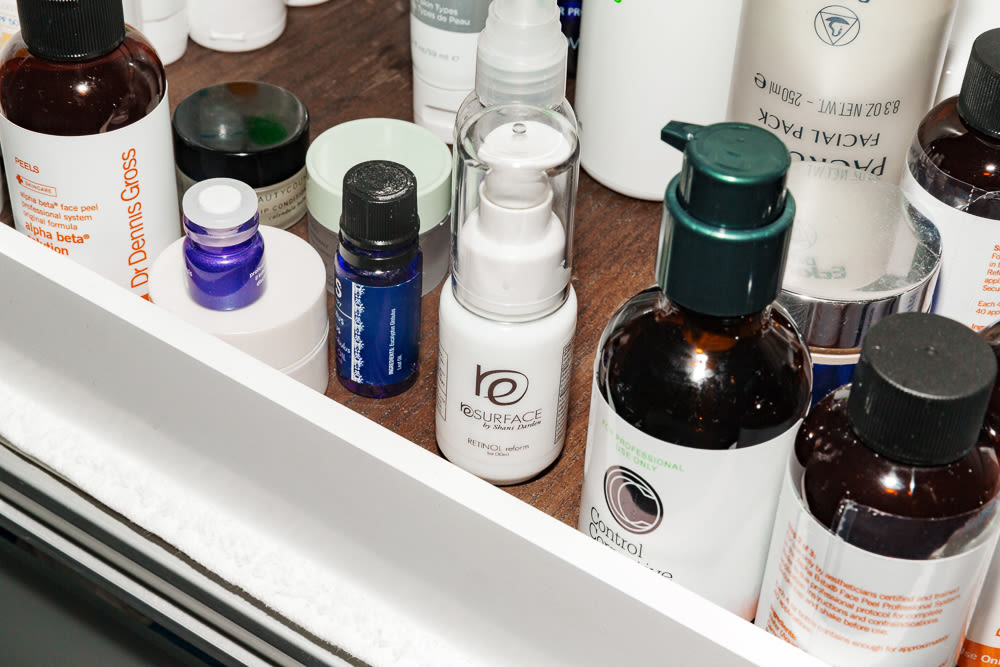Jackson Maine has Ally, and Into The Gloss has retinol. Our skincare star. The essential, perfectly-crafted beauty hero deserving of the main stage. You’ve probably heard of it, but using it is another story. Somehow the most celebrated skincare ingredient is also the most complicated—saddled with a potential awkward first few weeks of use, confusing labels (is retinyl palmitate the same thing as retinol or what?), and when the heck are you supposed to use it anyway? Let Shani Darden help. She’s the retinol facial genie, with the celebrity client list to back her up (hello Kelly Rowland’s face), and the greatest retinol product on the market. Shani’s facial and retinol are tough to get—you’ll wait for months for the former and spend $$$ on the latter—so here’s the next best thing. A guide! Shani is here today to impart her retinol wisdom on you, free of charge. All your questions—maybe more—answered. Here:
First things first, why retinol?
Good question! Glad you asked. Retinol is a topical derivative of vitamin A that promotes skin cell turnover and enhances collagen production. You can find it in a variety of skincare products—from creams to serums to oils—and in a variety of potencies (from .25-percent concentration to 2-percent). Don’t confuse it with the faster-acting stuff that requires a prescription. That’s pure retinoic acid—Retin-A, Renova—to name a few brands. Retinoic acid is retinol’s bigger sister that works more effectively, however it’s coupled with more potential side effects like flaky skin and redness. But enough about that now, you can read more of the science-y nitty-gritty here.
What makes it better than say...salicylic acid or vitamin C?
"All three are amazing ingredients, but retinol is one of my favorite ingredients because it works deep below the skin at the cellular level to encourage turnover and reveal fresh, bright skin," says Shani. Unlike salicylic acid and vitamin C—which work by sloughing off the dead cells that otherwise build up—retinol promotes healing and cellular repair on a more detail-oriented, microscopic scale. Like scrubbing a room with a toothbrush versus a Swiffer—both get the job done, although one more precisely so than the other. "It’s a true multi-tasker and has so many amazing benefits," Shani continues. "It boosts collagen in the skin, reduces fine lines and wrinkles, smoothes the texture of the skin, reduces pigmentation, and it can also help with acne. But it’s not an exfoliant! It is often mistaken for one because it helps speed up the rate that new skin comes to the surface."
How do I get started?
Because using a retinol at night is best, Shani recommends that you "Start with one night a week and build up slowly, tacking on an additional night each subsequent week. It’s important to build up to whatever works best for your skin. Some are able to use it every single night. Others, like people with sensitive skin, may only be able to use it every other night or even less."
What other beauty products can I pair my retinol with?
"Lactic acid pairs really well with retinol! I formulated my Texture Reform to include lactic acid for a gentle exfoliation to boost the already amazing benefits. On nights when I use retinol, I might also follow up with a hyaluronic acid serum and then a moisturizer if I need it. That’s it!"
On the other hand...what should retinol not be mixed with?
"Generally, I feel it is best to not layer too many products at once, whether you are using a retinol or not. It can reduce how well the products work in general. It may also cause chemical burns. Avoid chemical peels while using retinol, unless you have consulted with an esthetician or doctor first."
What's the best way to start using retinol to avoid the "uglies" (potential side effects like dermatitis, rashes, bumps, etc.)?
"The best way to mitigate the side effects is by building up slowly to allow your skin time to acclimate. Always wear sunscreen in the daytime, as retinol makes your skin more sensitive to the sun. I created my new product, Texture Reform, with retinyl palmitate [the most gentle form of vitamin A, which is a combination of retinol and palmitic acid] to help people sensitive to retinol build up a tolerance."
Once I'm on retinol, can I ever stop? Will it fix my skin like Accutane?
"There are no side effects to simply stopping, so you can stop anytime you like. However, retinol does slow down the aging process. It will make a big difference for your skin, but you have to keep using it regularly for the long-term benefits. You know I’ll be using retinol for the rest of my life!"
Lastly, how can I maximize the results?
"Long term use of retinol is the best way to maximize the results. It takes about six to eight weeks for your skin to turn over. Retinol will speed up the process of cellular turnover, but it is still going to take multiple weeks to see results."
Photo via ITG

